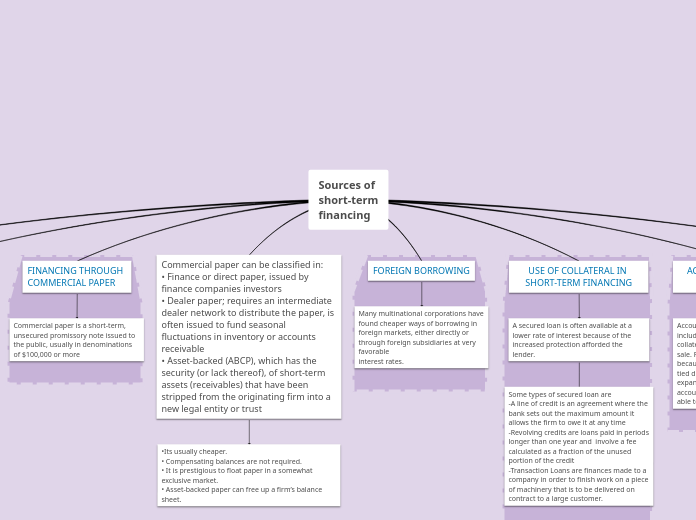Sources of
short-term
financing
HEDGING TO REDUCE BORROWING RISK
One way to reduce risk is through interest rate hedging activities in the financial futures market. Hedging means to engage in a transaction that partially or fully reduces a prior risk exposure.
ACCOUNTS RECEIVABLE FINANCING
Accounts receivable financing may include pledging receivables as collateral for a loan or an outright sale. Receivables financing is popular because it permits borrowing to be tied directly to the level of asset expansion at any time. As the level of accounts receivable goes up, we are able to borrow more.
USE OF COLLATERAL IN SHORT-TERM FINANCING
A secured loan is often available at a lower rate of interest because of the increased protection afforded the lender.
Some types of secured loan are
-A line of credit is an agreement where the bank sets out the maximum amount it allows the firm to owe it at any time
-Revolving credits are loans paid in periods longer than one year and involve a fee calculated as a fraction of the unused portion of the credit
-Transaction Loans are finances made to a company in order to finish work on a piece of machinery that is to be delivered on contract to a large customer.
FOREIGN BORROWING
Many multinational corporations have found cheaper ways of borrowing in foreign markets, either directly or through foreign subsidiaries at very favorable
interest rates.
FINANCING THROUGH COMMERCIAL PAPER
Commercial paper is a short‐term, unsecured promissory note issued to the public, usually in denominations of $100,000 or more
Commercial paper can be classified in:
• Finance or direct paper, issued by finance companies investors
• Dealer paper; requires an intermediate dealer network to distribute the paper, is often issued to fund seasonal fluctuations in inventory or accounts receivable
• Asset‐backed (ABCP), which has the security (or lack thereof), of short‐term assets (receivables) that have been stripped from the originating firm into a new legal entity or trust
•Its usually cheaper.
• Compensating balances are not required.
• It is prestigious to float paper in a somewhat exclusive market.
• Asset‐backed paper can free up a firm’s balance sheet.
BANK CREDIT
Banks may provide funds to finance seasonal needs, product‐line expansions, long‐term growth
Most bankers prefer a self‐liquidating loan, wich generates cash flows that forms a built‐in, or automatic, repayment scheme.
Demand loans (short-term and self-liquidating) are repayable at any time by the borrower or full payment can be “demanded” by the bank at any time.
These most often carry a variable interest rate
The prime rate is the rate the bank charges to its most creditworthy customers, scales based on the risk of the borrower
Banks will often charge fees
Trade credit
The manufacturer or seller of goods and services is the largest provider of short term financing
-Almost 50 percent of short‐term financing comes from trade credit.
-Trade credit (period) extends for 30 to 60 days depending on the industry.
-Cash discount reduces price if payment is made in a certain time period.

